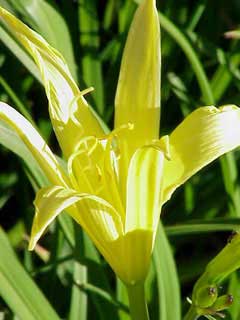
Citron daylily
Latin Name: Hemerocallis citrina
USDA Hardiness: 4-8
Native Range: TEMPERATE ASIA: China (Anhui Sheng, Hebei Sheng, Henan Sheng, Hubei Sheng, Hunan Sheng, Jiangsu Sheng, Jiangxi Sheng, Nei Mongol Zizhiqu, Shaanxi Sheng, Shandong Sheng, Sichuan Sheng, Zhejiang Sheng), Korea, Japan (Honshu, Kyushu, Shikoku)
Edibility Rating: 4 / 5
Medicinal Rating: 1 / 5
Region:
Family:
Plant Type:
Medicinal Uses
Edible Uses
Edible Parts: Flowers Leaves Root Shoots | Edible Uses: Leaves and young shoots - cooked[205]. They must be consumed when very young or else they become fibrous[K]. Flowers and flower buds - raw or cooked[105, 177]. The flowers can be dried and used as a thickener in soups etc. The slender trumpets vary from 12 - 17cm long[205]. There can be from 7 to 65 buds on a flowering stem[205]. The flower buds contain about 43mg vitamin C per 100g, 983 IU vitamin A and 3.1% protein[205]. Root - raw or cooked[205]. The flavour is somewhat radish-like but not so sharp[205].
Cultivation
Succeeds in most soils[1], including dry ones, preferring a rich moist soil[200]. Grows well in heavy clay soils. Succeeding in sun or shade, it produces more flowers in a sunny position though these flowers can be shorter-lived in very sunny positions[205]. Succeeds in short grass if the soil is moist[1]. Prefers a pH between 6 and 7[200]. Plants are hardy to at least -20°c[187]. Widely cultivated in China for its edible flowers, especially in Hunan province[266]. Hybridizes freely with other members of this genus[200]. This species is said to be self-incompatible[127, 205]. Many of the plants in cultivation under this name are H. thunbergii[205]. The sub-species H. citrina vespertina (Hara.)Erhardt. is a very free-flowering form, producing up to 75 buds per scape and capable of flowering from July to October if the weather is suitable[205]. The plant forms a loose spreading clump[K]. The roots form pseudobulbs[205]. Plants take a year or two to become established after being moved[1]. Plants seem to be immune to the predations of rabbits[233]. The plants are very susceptible to slug and snail damage, the young growth in spring is especially at risk[200]. Individual flowers are very short-lived, they open in the late afternoon and die in the morning[200]. However, plants produce a succession of flowers for several weeks of the summer. The number of flowers on a scape varies from 7 to 65[205]. The flowers have a lemony scent[205]. Another report says that they have a pronounced honeysuckle scent[245].
Known Hazards
Large quantities of the leaves are said to be hallucinogenic. Blanching the leaves removes this hallucinatory component[205]. (This report does not make clear what it means by blanching, it could be excluding light from the growing shoots or immersing in boiling water[K].)
Habitats
Forest margins, grassy fields and slopes along valleys from near sea level to 2000 metres[266].